1994 PONTIAC BONNEVILLE traction control
[x] Cancel search: traction controlPage 75 of 290
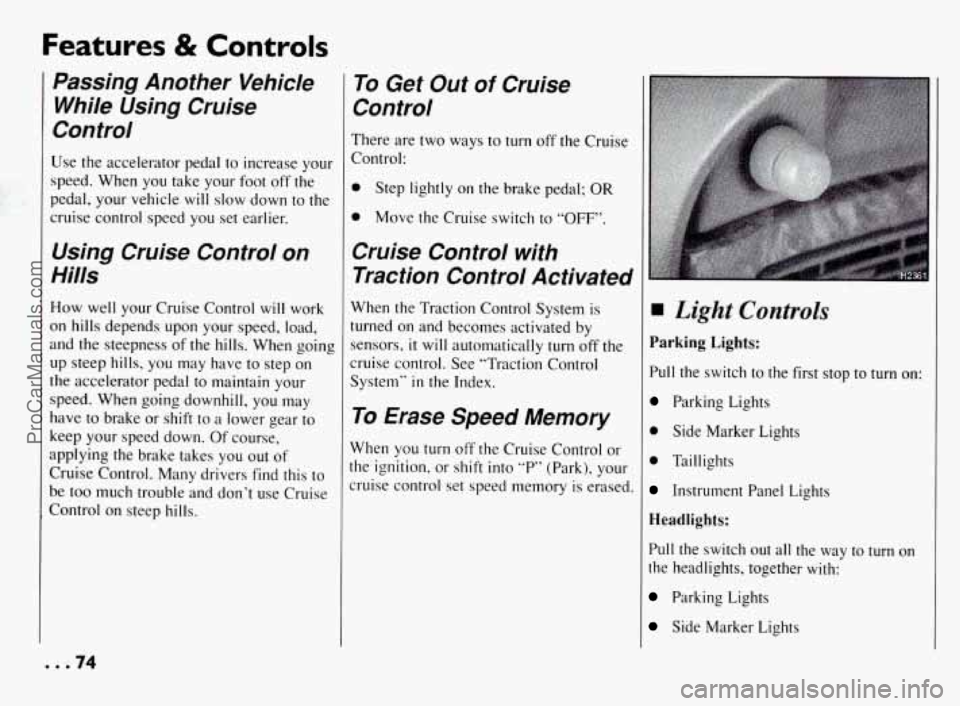
Features & Controls
Passing Another Vehicle While Using Cruise
Control
Use the accelerator pedal to increase your
speed. When you take your foot off the
pedal, your vehicle will
slow down to the
cruise control speed
you set earlier.
Using Cruise Control on
Hills
How well your Cruise Control will work
on hills depends upon your speed, load,
and the steepness of the hills. When going
up steep hills, you may have to step on
the accelerator pedal to maintain your
speed. When going downhill, you may
have to brake or shift to a lower gear to
keep
your speed down. Of course,
applying the brake takes you out
of
Cruise Control. Many drivers find this to
be too much trouble and don't use Cruise
Control on steep hills.
To Get Out of Cruise
Control
There are two ways to turn off the Cruise
Control:
0 Step lightly on the brake pedal; OR
0 Move the Cruise switch to "OFF".
Cruise Control with
Traction Control Activated
When the Traction Control System is
turned on and becomes activated by
sensors,
it will automatically turn off the
cruise control. See "Traction Control
System"
in the Index.
To Erase Speed Memory
When you turn off the Cruise Control or
the ignition, or shift into "P7 (Park), your
cruise control set speed memory is erased.
Light Controls
Parking Lights:
Pull the switch to the first stop to turn on:
Parking Lights
0 Side Marker Lights
0 Taillights
Instrument Panel Lights
Headlights:
Pull the switch out all the way to turn on
the headlights, together with:
Parking Lights
Side Marker Lights
ProCarManuals.com
Page 99 of 290
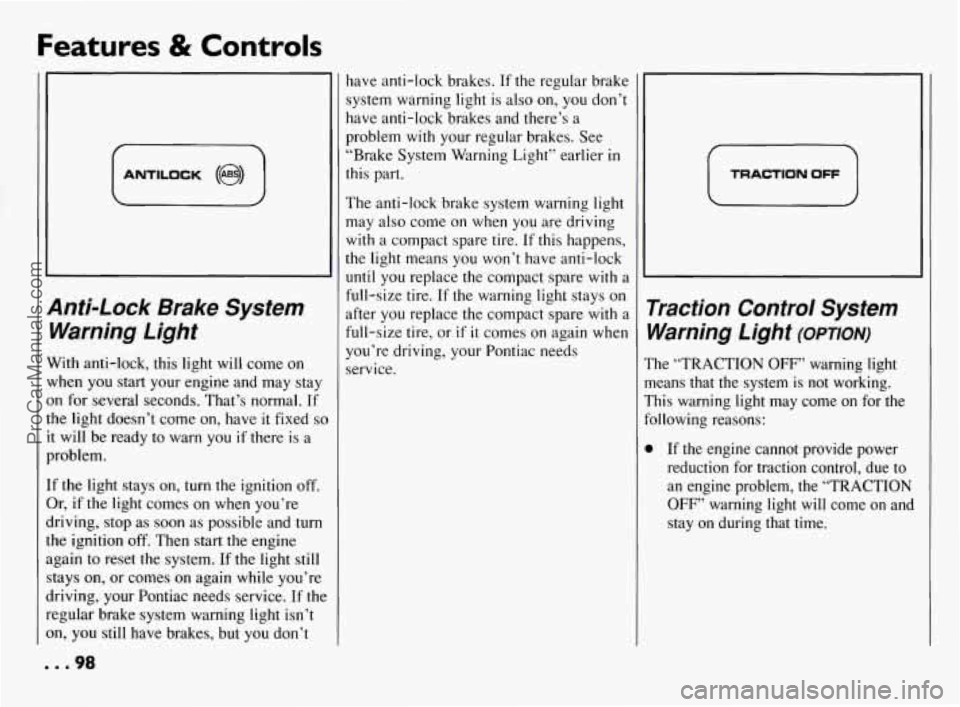
Features & Controls
rn ANTILOCK (@)
Anti-Lock Brake System Warning Light
With anti-lock, this light will come on
when you start your engine and may stay
on for several seconds. That’s normal. If
the light doesn’t come on, have it fixed
so
it will be ready to warn you if there is a
problem.
If the light stays on, turn the ignition off.
Or, if the light comes on when you’re
driving, stop as soon as possible and turn
the ignition
off. Then start the engine
again to reset the system. If the light still
stays on, or comes on again while you’re
driving, your Pontiac needs service. If the
regular brake system warning light isn’t
on, you still have brakes, but you don’t have anti-lock brakes.
If the regular brake
system warning light is also on, you don’t
have anti-lock brakes and there’s a
problem
with your regular brakes. See
“Brake System Warning Light” earlier
in
this part.
The anti-lock brake system warning light
may also come on when
you are driving
with a compact spare tire. If this happens,
the light means you won’t have anti-lock
until you replace the compact spare with a
full-size tire. If the warning light stays on
after you replace the compact spare with a
full-size tire, or
if it comes on again when
you’re driving, your Pontiac needs
service.
i TRACTION OFF
Traction Control System Warning Light
(omoN)
The “TRACTION OFF” warning light
means that the system is not working.
This warning light may come on for the
following reasons:
0 If the engine. cannot provide power
reduction for traction control, due to
an engine problem, the “TRACTION
OFF” warning light will come on and
stay on during that time.
... 98
ProCarManuals.com
Page 100 of 290

To prevent overheating, the traction control system will go off and the warning light will come on
until your
brakes cool down. The warning light
will come
on for varying periods of
time.
If
you turn the system off by pressing
the switch on the center console while
the vehicle is at any speed, the warning light will come
on and stay
on. To turn the system back on, press
the switch again at any vehicle speed.
The warning light should
go off. The
system
will also turn itself on if you
turn your ignition off and back on
again. When this warning light is
on, the
system
will not limit wheel spin. Adjust your
driving accordingly.
If the “TRACTION OFF” warning light
comes
on and stays on for an extended
period
of time, even when you’ve
switched the system on, your vehicle
needs service.
Gages
Your Pontiac may have many of the
following gages. Be sure to read about the
mes that came with your vehicle.
I
990..
ProCarManuals.com
Page 144 of 290
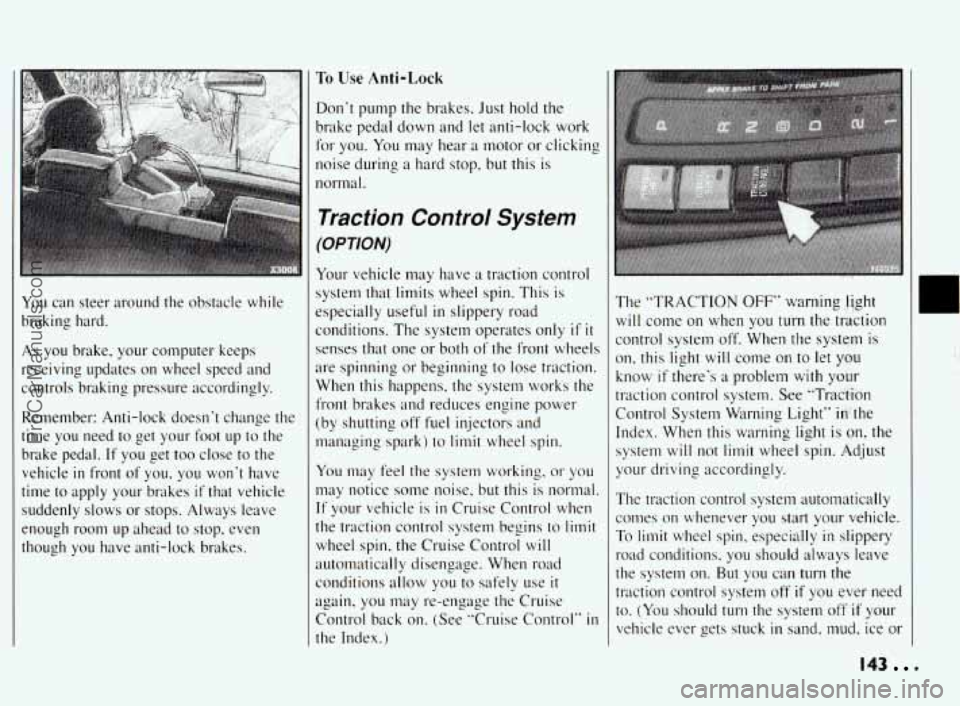
I
You can steer around the obstacle while
braking hard.
As you brake, your computer keeps
receiving updates
on wheel speed and
controls braking pressure accordingly.
Remember: Anti-lock doesn‘t change the
time you need to get your foot up to the
brake pedal.
If you get too close to the
vehicle
in front of you, you won’t have
time to apply your brakes
if that vehicle
suddenly slows
or stops. Always leave
enough room up ahead
to stop, even
though you have anti-lock brakes.
To Use Anti-Lock
Don’t pump the brakes. Just hold the
brake pedal down and let anti-lock work
for you.
You may hear a motor or clicking
noise during a hard stop, but
this is
normal.
Traction Control System
(OPTION)
Your vehicle may have a traction control
system that limits wheel spin. This is
especially useful
in slippery road
conditions. The system operates only
if it
senses that one or both of the front wheels
are spinning or beginning to lose traction.
When this happens, the system works the
front brakes and reduces engine power
(by shutting off fuel injectors and
managing spark) to
limit wheel spin.
You may feel the system working, or you
may notice some noise, but this is normal.
If your vehicle is in Cruise Control when
the traction control system begins
to limit
wheel spin, the Cruise Control will
auto~natically disengage. When road
conditions allow you to safely use
it
again, you may re-engage the Cruise
Control back on. (See “Cruise Control”
in
the Index.) The “TRACTION
OFF” warning
light
will come on when you turn the traction
control system off.
When the system is
on, this light will come
on to let you
know if there’s a problem with your
traction control system. See “Traction
Control System Warning Light” in’the
Index. When this warning light is on, the
system
will not limit wheel spin. Adjust
your driving accordingly.
The traction control system automatically
comes on whenever you start
your vehicle.
To limit wheel spin, especially
in slippery
road conditions, you should always leave
the system
on. But you can turn the
traction control system
off if you ever need
to. (You should
turn the system off if your
vehicle ever gets stuck
in sand. mud, ice or
143
ProCarManuals.com
Page 145 of 290

Your Driving and the Road
Traction Control System
(OPTION) (CONI)
snow. See “Rocking Your Vehicle” in the
Index.)
To turn the system off, press the
“TRACTION CONTROL” button.
The “TRACTION
OFF” warning light
will come on and stay on. If the system is
limiting wheel spin when
you press the
button, the system won’t turn off right
away. It will wait until there’s no longer a
current need to limit wheel spin.
You can turn the system back on at any
time by pressing the button again. The
“TRACTION
OFF” warning light
should go off.
Braking in Emergencies
Use your anti-lock braking system when
you need to. With anti-lock, you can steer
and brake at the same time. In many
emergencies, steering can help
you more
than even the very best braking.
Steering
Power Steering
If you lose power steering assist because
the engine stops or the system is not
functioning,
you can steer but it will take
much more effort.
Variable Effort Steering
If your vehicle is equipped with this
option,
you have a variable effort steering
system that eases steering effort at speeds
less than
20 mph (32 km/h). This is
particularly useful when parking your
vehicle.
Steering Tips
Driving on Curves
It’s important to take curves at a
reasonable speed.
A lot of the “driver lost control” accidents
mentioned on the news happen on curves.
Here’s why: Experienced driver or beginner, each
of
us is
subject to the same laws of physics
when driving on curves. The traction
of
the tires against the road surface makes it
possible for the vehicle to change its path when
you turn the front wheels. If there’s
no traction, inertia will keep the vehicle
going in the same direction. If you’ve
ever tried to steer a vehicle on wet
ice,
you’ll understand this.
The traction you can get in a curve
depends on the condition of your tires and
the road surface;
the angle at which the
curve is banked, and your speed. While
you’re in a curve, speed is the one factor
you can control.
Suppose you’re steering through a sharp
curve. Then
you suddenly accelerate.
Both control systems
-- steering and
acceleration
-- have to do their work
where the tires meet the road. Unless
you
have traction control and the system is on,
adding the sudden acceleration can
demand too much
of those places. You
can lose control.
... 144
ProCarManuals.com
Page 148 of 290
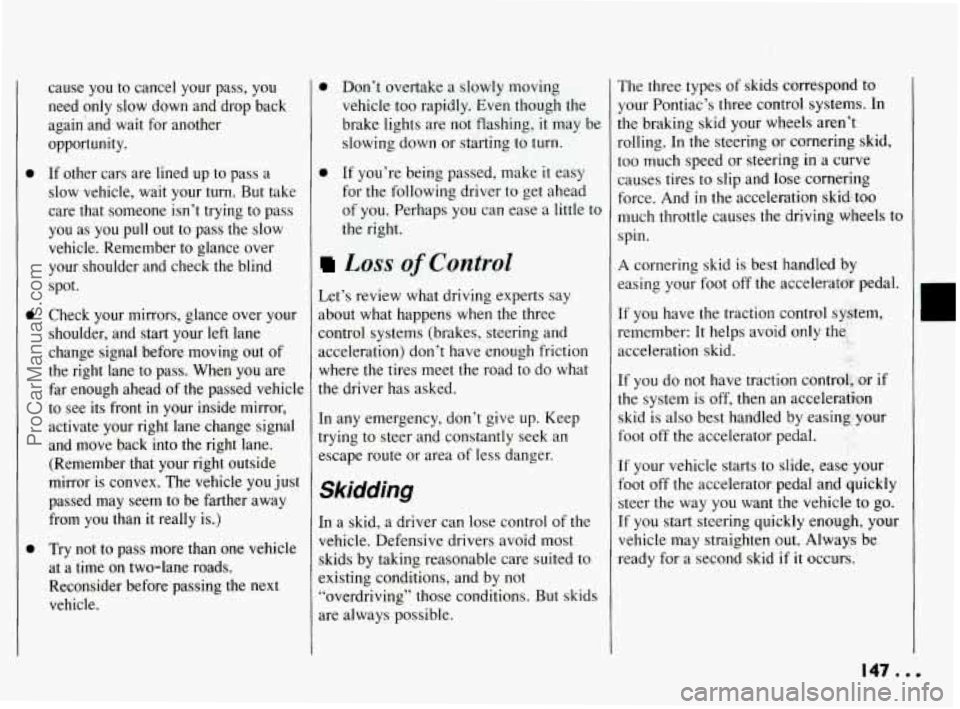
0
0
0
cause you to cancel your pass, you
need only slow down and drop back
again’and wait for another
opportunity.
If other cars are lined up to pass a
slow vehicle, wait your turn. But take
care that someone isn’t trying to pass
you as you pull out to pass the slow
vehicle. Remember to glance over
your shoulder and check the blind
spot.
Check your mirrors, glance over your
shoulder, and start your left lane
change signal before moving out of
the right lane to pass. When you are
far enough ahead of the passed vehicle
to see its front
in your inside mirror,
activate your right lane change signal
and move back into the right lane.
(Remember that your right outside
mirror is convex. The vehicle you just
passed may seem to be farther away
from you than it really is.)
Try not to pass more than one vehicle
at a time on two-lane roads.
Reconsider before passing the next
vehicle.
0 Don’t overtake a slowly moving
vehicle too rapidly. Even though the
brake lights are not flashing, it may be
slowing down or starting to turn.
0 If you’re being passed, make it easy
for the following driver
to get ahead
of you. Perhaps you can ease a little to
the right.
Loss of Control
Let’s review what driving experts say
about what happens when the three
zontrol systems (brakes, steering and
acceleration) don’t have enough friction
where the tires meet the road to do what
the driver has asked.
In any emergency, don’t give up. Keep
trying to steer and constantly seek an
escape route or area of less danger.
Skidding
In a skid, a driver can lose control of the
vehicle. Defensive drivers avoid most
skids by taking reasonable care suited to
existing conditions, and by not
“overdriving” those conditions. But skids
are always possible. The
three types of skids correspond
to
your Pontiac’s three control systems. In
the braking skid your wheels aren’t
rolling. In the steering
or cornering skid,
too much speed or steering in a curve
causes tires to slip and lose cornering
force. And
in the acceleration skic€-.too
much throttle causes the driving wheels to
spin.
A cornering skid is best handled by
easing your foot off the accelerato? pedal.
If you have the traction control system,
remember: It helps avoid only the,
acceleration skid.
If you do not have traction control$ or if
the system is off, then an acceleration
skid is
also best handled by easing your
foot off the accelerator pedal.
If your vehicle starts to slide, ease your
foot off the accelerator pedal and quickly
steer the way you want the vehicle to
go.
If you start steering quickly enough, your
vehicle may straighten out. Always
be
ready for a second skid if it occurs.
147...
ProCarManuals.com
Page 149 of 290
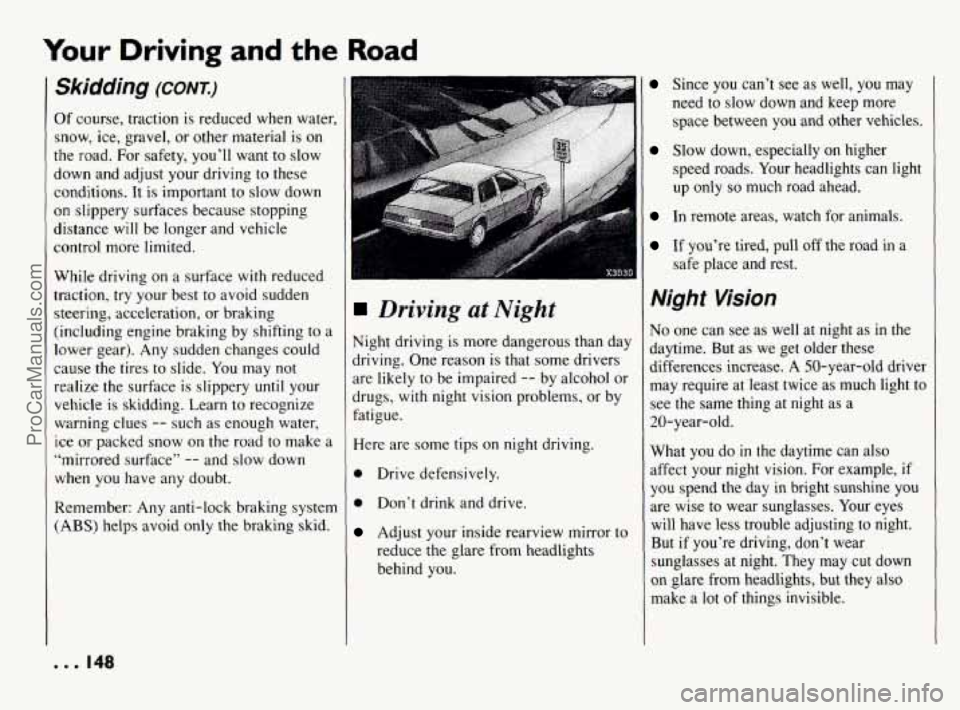
Your Driving and the Road
Skidding (CONI)
Of course, traction is reduced when water,
snow, ice, gravel, or other material is on
the road. For safety, you’ll want to slow
down and adjust your driving to these
conditions. It is important to slow down
on slippery surfaces because stopping
distance
will be longer and vehicle
control more limited.
While driving on a surface with reduced
traction, try your best to avoid sudden
steering, acceleration, or braking
(including engine braking by shifting to a
lower gear). Any sudden changes could
cause the tires
to slide. You may not
realize the surface is slippery until your
vehicle is skidding. Learn to recognize
warning clues
-- such as enough water,
ice
or packed snow on the road to make a
“mirrored surface”
-- and slow down
when
you have any doubt.
Remember: Any anti-lock braking system
(ABS) helps avoid only the braking skid.
Driving at Night
Night driving is more dangerous than day
driving. One reason is that some drivers
are likely to be impaired
-- by alcohol or
drugs, with night
vision problems, or by
fatigue.
Here are some tips on night driving.
0 Drive defensively.
0 Don’t drink and drive.
Adjust your inside rearview mirror to
reduce the glare from headlights
behind you.
Since you can’t see as well, you may
need to slow down and keep more
space between you and other vehicles.
Slow down, especially on higher
speed roads. Your headlights can light
up only so much road ahead.
In remote areas, watch for animals.
If you’re tired, pull off the road in a
safe place and rest.
Night Vision
No one can see as well at night as in the
daytime.
But as we get older these
differences increase.
A 50-year-old driver
may require at least twice as much light to
see the same thing at night as a
20-year-old.
What you do
in the daytime can also
affect your night vision. For example, if
you spend the day
in bright sunshine you
are wise to wear sunglasses. Your eyes
will have less trouble adjusting to night.
But if you’re driving, don’t wear
sunglasses at night. They may cut down
on glare from headlights, but they also
make a lot of things invisible.
. . . 148
ProCarManuals.com
Page 157 of 290

Your Driving and the Road
Driving on Snow or Ice
(CONT.)
What’s the worst time for this? “Wet ice.”
Very cold snow or
ice can be slick and
hard to drive
on. But wet ice can be even
more trouble because it may offer the
least traction of all.
You can get “wet ice”
when it’s about freezing
(32°F; OOC) and
freezing rain begins to fall. Try to avoid
driving
on wet ice until salt and sand
crews can get there.
Whatever the condition
-- smooth ice,
packed, blowing or loose snow
-- drive
with caution.
If
you have traction control, keep the
system on. It will improve your ability to
accelerate when driving
on a slippery
road. Even though your vehicle has a
traction control system,
you’ll want to
slow down and adjust your driving
to the
road conditions. See “Traction Control
System”
in the Index.
If
you don’t have the traction control
system, accelerate gently. Try not to break
the fragile traction. If
you accelerate too
fast, the drive wheels will spin and polish
the surface under the tires even more. Your
anti-lock brakes improve
your
ability to make a hard stop on a slippery
road. Even though
you have the anti-lock
braking system, you’ll want
to begin
stopping sooner than you would
on dry
pavement. See “Anti-lock”
in the Index.
0 Allow greater following distance on
any slippery road.
Watch for slippery spots. The road
might be fine until
you hit a spot that’s
covered with ice. On an otherwise
clear road, ice patches may appear in
shaded areas where the
sun can’t
reach: around clumps of trees, behind
buildings, or under bridges.
Sometimes the surface of a curve or
an overpass may remain icy when the
surrounding roads are clear. If you see
a patch of ice ahead of you, brake
before
you are on it. Try not to brake
while you’re actually on the ice, and
avoid sudden steering maneuvers.
If You’re Caught in a
Blizzard
If you are stopped by heavy snow, you
could be
in a serious situation. You should
probably stay with your vehicle unless
you know for sure that you are near help and you can hike through the snow. Here
are some things to do to summon help and
keep yourself and your passengers safe:
0
0
Turn on your hazard flashers.
Tie a red cloth to your vehicle to alert
police that you’ve been stopped by the
snow.
... 156
ProCarManuals.com